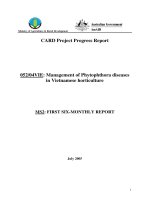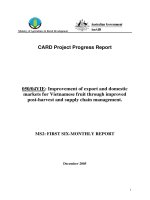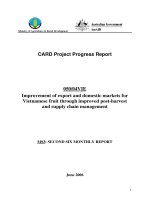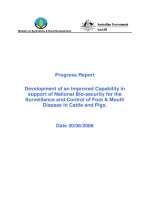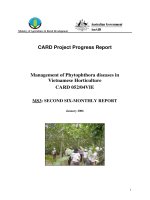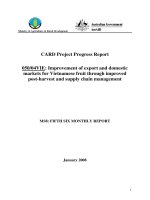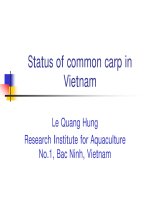Báo cáo nghiên cứu khoa học: " EFFECTS OF LEADERSHIP ON LEADER REPUTATION " potx
Bạn đang xem bản rút gọn của tài liệu. Xem và tải ngay bản đầy đủ của tài liệu tại đây (263.71 KB, 7 trang )
TẠP CHÍ PHÁT TRIỂN KH&CN, TẬP 9, SỐ 3-2006
Trang 73
EFFECTS OF LEADERSHIP ON LEADER REPUTATION
Kim Dung Tran
(1)
, Morris Abraham
(2)
(1) University of Economics, Ho Chi Minh city.
(2) University of Technology, Sydney.
(Manuscript Received on November 29
th
, 2005)
ABSTRACT : This study investigated the relationships between leadership and
overall leader reputation. Empirical tests on 293 full-time employees in Hochiminh city,
using structural equation modeling, confirmed the validity of both the Chinese Implicit
Leadership Scale [CILS] [1] and the overall leader reputation measures used in the
research. CILS has four dimensions but only two of these - Goal Effectiveness (0.49) and
Personal Morality (0.27) had statistically significant effects on overall leader reputation.
No differences between public and non-public sector employees were found in relation to
the effects of leadership dimensions on overall leader reputation. Apart from stimulating
further leadership research, the findings of this study could draw management’s attention
to new criteria in recruitment, performance appraisal as well as for management
education and development practice in a Vietnamese context.
Keywords: Leadership; leader reputation; confirmatory factor analysis; Vietnam.
1. Introduction
Leadership in organizations has
been a topic of intense interest to both
academics and practitioners for many
years [2]. However in Vietnam, there is a
dearth of quantitative research in this area.
Consequently, managers in Vietnam do
not know what scales of leadership are
appropriate for Vietnamese organizations,
and hence what leader characteristics have
the strongest impact on leader reputation.
The main objective of this study
was to examine the effects of leadership
characteristics on overall leader
reputation. Apart from stimulating
further leadership research, the findings
of this study will provide practical
guidelines for recruitment, performance
appraisal as well as for management
education and development practice in a
Vietnamese context.
2. Theoretical framework and research
hypotheses
2.1 Leadership
Leadership has been studied intensively
in terms of traits/characteristics,style and
contingency factors [3]. Most of the
research on leadership measurement
conducted in North America and Western
Europe has focused mostly on leadership
abilities. In China, Ling and Fang [1]
have developed the Chinese Implicit
Leadership Scale (CILS) with four
independent dimensions:(1) Personal
Morality, (2) Goal Effectiveness, (3)
Interpersonal Competence, and (4)
Versatility. These dimensions are quite
different from those arising from a
previous study with US participants
(Offerman et al.,1994). In the US the
authors found eight factors (Sensitivity,
Dedication, Tyranny, Charisma,
Attractiveness, Masculinity, Intelligence
and Strength). According to Ling et al,
Western findings differ from leadership
in China where: “Chinese participants
consider virtue as the most important
feature of leadership” [4, p. 736]. The
authors point out four reasons for the
importance of moral character in Chinese
leadership models: (a) the strategic
emphasis placed on morality for selecting
TẠP CHÍ PHÁT TRIỂN KH&CN, TẬP 9, SỐ 3-2006
Trang 74
and assessing cadres within China’s
administration; (b) the weight which the
traditional culture accords to moral
integrity; (c) the weakness of the legal
system in safeguarding social justice; and
(d) the highly centralized power structure
which places a premium on the
benevolence of enlightened leaders with
moral character [1,p.184]. These reasons
also apply to Vietnamese conditions. In
addition, Vietnam shares many features
with China such as: (a) Similarity of the
two cultures during feudalism; (b)
Similarity of a socialist type of HRM,
and (c) The fact that both countries are in
transition to a market oriented economy.
Thus, the Chinese leadership model
appears more relevant than a Western
one for leadership assessment research in
Vietnam. As this research represents the
first time that the CILS has been applied
in Vietnam, we need to examine its
validity.
2.2 Leader’s reputation
Leader reputation is important
from a number of perspectives. The
leader's reputation can be seen as an asset
by which a business organization can
extend its influence and control over
government, workers and the consumer
market. According to Leslie Gaines-Ross
[5], CEO's and corporate reputation are
inextricably linked and have a proven
impact on the bottom line. Regardless of
the size and complexity of the
organization, the CEO defines the style,
and becomes the company's public face.
Employees, customers, shareholders,
analysts and the media all monitor the
CEO for insights into the firm's culture,
values, and commitment to what the
brand represents.
According to Hall [2] although
reputation is commonly referred to in
organizational research, most researchers
never explicitly define it; rather,
definitions of reputation are implied
through the context of its use. Based on
Ferris’s and his colleagues [6] definition
of personal reputation, Hall, [2,p. 518]
suggests that leader reputation is a
perceptual identity of a leader as held by
others that serves to reduce the
uncertainty regarding the expected future
behavior of that leader. As the result, a
leader with a higher reputation is
regarded with a higher degree of trust, is
monitored less, and held to lower
accountability standards than a leader
with a lesser reputation.
The network to which an
individual belongs can be a source of that
individual's reputation as a good
performer [7]. A CEO needs to deal with
multiple and often incompatible
audiences eg employees and financiers
who may have quite distinct and even
opposing interests [8]. In fact, a
particular leader’s reputation could well
be evaluated from the viewpoint of
different stakeholders – e.g. government,
customers, community, employees, peers
and so on. In this paper, we investigate
the construct ‘leader reputation’ from the
employees’ perception only, and leader
reputation is measured through
subordinates’ recognition, respect and
admiration for the particular leader.
2.3. Leadership and leader reputation
According to Williams et al [9,
p.906] “from theoretical standpoints, it is
often reasonable to view specific
constructs as causes of general
constructs”. Hall [2] argues that different
qualities, features, and characteristics
combine in varying degrees depending
upon the context, and as such contribute
to leader reputations. Thus, leadership
characteristics can be seen as the causes
of leader reputations. In Vietnam,
leadership assessment has been focused
on two such qualities as “Red” (meaning
morality) and “Expertise” (meaning
ability). Red gets accorded a higher
weight than Expertise [10]. Similar to the
Chinese case, it can predict:
H1: Personal morality has stronger
effects on Leader Reputation than Goal
Effectiveness.
In Vietnam, the public sector
accounted for 10 per cent of the labor
force but nearly 50 per cent GDP in 2003
TẠP CHÍ PHÁT TRIỂN KH&CN, TẬP 9, SỐ 3-2006
Trang 75
[11]. Management education, training
and development programs in the public
sector focus on political ideology and
morality more than that in the non-public
sector. What employees expect from
their CEOs may therefore differ
according to whether particular sector
within which such assessment is
conducted. It is further anticipated that in
assessing leadership reputation,
employees in the public sector will tend
to focus more upon Personal Morality
while employees in non-public sector
will focus more upon Goal Effectiveness.
Hence:
H2: The effects of Personal Morality on
the Overall Leader Reputation are more
positive for employees in the public
sector than for employees in the non-
public sector.
H3: The effects of Goal Effectiveness on
the Overall Leader Reputation are more
positive for employees in the non-public
sector than for employees in the public
sector.
3. Method
3.1 Sample and data collection
The data was collected using a
face-to-face questionnaire. The
questionnaire was completed by 281
evening students at the University of
Economics, Hochiminh City. The sample
comprised 42% male and 58% female;
39.8% managers; 60.2% non-managers.
There were 57.3% employees in public
sector, 42.7% employees in private
sector. Of the subjects, 78.8% are
younger than 35 years of age and only
4% were over 45 years of age.
3.2 Measures Leadership.
The Chinese Implicit Leadership
Scale [1] was applied for the
measurement of leadership
characteristics. Participants were asked to
state how the CILS characteristics
applied to their CEO’s. A focus group
with 8 full time employees in Ho Chi
Minh City was applied before the survey.
Based upon the focus group, two
observed variables were removed from
the CILS. Two items: a) “Well read”,
which was not suitable in a Vietnamese
context and b) “Cheerful” which was
repeated in two factors (Interpersonal
Competency and Versatility) was
eliminated in Versatility. Finally, scales
for Personal Morality included 10 items
(coefficients alpha α = 0.894); Goal
Effectiveness had 10 items (α = 0.871);
Interpersonal Competency had 10 items,
(α = 0.881); Versatility had 8 items (α =
0.850). A Likert seven-point scale was
employed, ranging from 1 (strongly
disagree) to 7 (strongly agree).
Leader reputation. Leader
reputation was measured with three
items: (a) All in all, your CEO is an
excellent leader; (b) All in all, you trust
your CEO; (c) All in all, you admire your
CEO. A seven-point Likert scale was
employed, ranging from 1 (strongly
disagree) to 7 (strongly agree). The
coefficients Cronbach alpha was 0.899.
4. Analytical strategy
Hypotheses were assessed through sets of
analyses. First we tested the validity of
CILS. As the scales of leader reputation
has only three items, its validity was
tested together with CILS in the final
measurement model through exploratory
factor analysis (EFA) and confirmatory
factor analysis (CFA). Amos 5.0 [12]
was employed to test CFA on validity
with unidimensionality, reliability,
convergent validity, discriminant
validity, and predictive validity [13].
Next, we estimated the effects of
leadership on the overall leader
reputation in a structural model. A multi
group analysis and a series of invariance
tests were applied to compare the
perception of two groups of public and
non-public employees for the effects of
leadership on the overall leader
reputation.
5. Results
Structural equation modeling
(SEM) was applied in the study due to it
being an ideal technique for refining and
testing construct validity [13]. The
standardized solutions were computed
completely by AMOS 5.0 and the ML
TẠP CHÍ PHÁT TRIỂN KH&CN, TẬP 9, SỐ 3-2006
Trang 76
estimation method was used for
estimation parameters and testing model
fit. The model produced a good fit with
χ
2
= 262.709; df= 142; p=0.000; GFI=
0.910; CFI= 0.958; TLI= 0.949; RMSEA
= 0.054. All standardized residual error
was smaller than 2.06; R
2
= 0.74. Two
dimensions: Interpersonal Competency;
and Versatility did not have significant
influences on leader reputation. T-test
with p < 0.05 showed that Goal
Effectiveness had statistical significant
effects (0.49) stronger on the overall
leader reputation than Personal Morality
(0.27) had. Descriptive statistics and
correlations among all remained
observed variables of a final
measurement model are provided in
Appendix 1.
A multi-group analysis and a
series of invariance tests were used to
compare the effects of leadership
dimensions on the overall leader
reputation in the public and non-public
sectors. Firstly, the difference of the
effects of Personal Morality on the
overall leader reputation in two sectors
was examined by constraining factor
loading A. Secondly, the difference of
the effects of Goal Effectiveness on the
overall leader reputation in two sectors
was examined by constraining factor
loading B. Finally, the difference of the
effects of Leadership on the overall
leader reputation in two sectors was
examined by constraining both factor
loadings A and B. The base line model
has χ
2
= 485.144, df =284. The
comparison between ∆ Chi-square and ∆
df provided p > 0.05 in all three models.
This proved no differences between the
perceptions of the two groups of
employees on the effects of leadership on
leader reputation.
6. Discussion and conclusions
This study examined the effects of
leadership on the overall leader
reputation. The validity of the adapted
Chinese Implicit Leadership Scale and
the overall leader reputation were
confirmed. Goal Effectiveness had
stronger effects (0.49) on overall leader
reputation than Personal Morality (0.27).
This did not support H1. No differences
were found in the effects of Personal
Morality or Goal Effectiveness on the
overall leadership for employees in
public and in non-public sectors. This
finding did not support H2 and H3. Thus
no hypotheses were supported. These can
be explained as follows:
In some aspects, Goal
Effectiveness with five indicators (Far-
sighted, Deliberate, Scientific, Insightful
and Seasoned) and Personal Morality
with four indicators (Honest, Impartial,
Trustworthy and Incorruptible) were seen
as similar to the two criteria “Expertise”
and “Red” in Vietnamese leadership
assessment. Similar to the Chinese case,
Personal Morality has been historically
considered as the first and most
important leadership characteristic
associated with the centrally planned
economy in Vietnam. However, some
differences are evident:
Firstly, economic reform in China
has been driven downwards from the top,
whereas, openness to a market economy
in the South of Vietnam before 1975; and
the force of operating business in a
strong competition has made economic
reform in Vietnam a “bottom up”
process [14].
Secondly, in the current transition
toward a market-oriented economy,
Vietnamese organizations are facing
serious problems due to a lack of
managerial knowledge and skills. Many
CEOs still function like government
officers rather than CEO’s in a Western
sense, and highly capable managers are
in short supply. This lack of knowledge
and skills negatively impacts upon
business results and employee income.
In the past, with a closed economy,
Vietnamese people were poor but lacked
awareness of their poverty [13].
However, the subsequent movement
toward a more open economy; the quick
growth of the Internet and other forms of
global communication have enabled
TẠP CHÍ PHÁT TRIỂN KH&CN, TẬP 9, SỐ 3-2006
Trang 77
employees to recognize this fact and to
struggle to improve their situation. In
more recent times living standards have
substantially improved and employee
demands for capable management also
have accordingly increased. It would
seem that modern business competition
has apparently altered employee
perception and blurred the differences in
leadership assessment criteria between
the public and non-public sectors. Goal
effectiveness seems to have become
paramount compared with issues of
morality regardless of the particular
sector. It is interesting to find that from
an employee aspect, leadership
assessment in Vietnam is moving more
toward a Western focus on capability
rather than the Chinese focus on
morality.
The research has some implications.
Firstly, the adapted scales for leadership
and the overall leader reputation appear
to be relevant for Vietnam.
Secondly, the findings that Vietnamese
employees consider Goal Effectiveness
as more important than Personal Morality
in leadership assessment, should draw
management's attention to focus more on
the “expertise” aspect on new criteria in
recruitment, performance evaluation and
management development.
Limitation and suggestion for further
research: The study has a limitation with
respect to its sample. It would be
interesting to compare the effects of
leadership on the overall leader
reputation for employees across
demographic variables; across main
types of business activities; and all types
of ownerships. As the sample size was
small; and respondents were collected by
convenient method, the result may not
generalize for other groups of employees
or for other areas of Vietnam. In
addition, although the CILS has been
tested to be relevant in Vietnam but it is
probably preferable to directly develop a
Vietnamese Implicit Leadership scale
based upon a much larger sample.
ẢNH HƯỞNG CỦA PHẨM CHẤT LÃNH ĐẠO ĐẾN UY TÍN LÃNH ĐẠO
Trần Kim Dung
(1)
, Morris Abraham
(2)
(1) Trường Đại học Kinh tế Tp.HCM
(2) Trường Đại học Cơng nghệ Sydney
TÓM TẮT: Nghiên cứu thực hiện khám phá mối quan hệ giữa phẩm chất lãnh đạo
và uy tín lãnh đạo. Kết quả kiểm định trên 293 nhân viên đang làm việc toàn thời gian ở
TP HCM, sử dụng mô hình phương trình cấu trúc đã khẳng định giá trị của thang đo
Người lãnh đạo lý tưởng của Trung Quốc theo nhận thức của nhân viên {CILS} do Ling
và Fang {1} thiế
t lập và thang đo uy tín lãnh đạo được sử dụng trong nghiên cứu. Thang
đo CILS có bốn đại lượng, nhưng chỉ có hai đại lượng: Hiệu quả mục tiêu (0.49) và Đạo
đức cá nhân (0.27) có ảnh hưởng có ý nghĩa thống kê đến uy tín lãnh đạo. Nghiên cứu
không tìm thấy sự khác biệt theo nhận thức của nhân viên trong khu vực quốc doanh và
phi quốc doanh về ảnh hưởng của các thành phần của phẩm chất lãnh đạo đến uy tín lãnh
đạo. Ngoài việc khuyến khích các nghiên c
ứu về nghệ thuật lãnh đạo, kết quả của nghiên
cứu này có thể thu hút sự quan tâm của quản trị đối với các tiêu thức mới trong hoạt động
tuyển dụng, đánh giá kết quả công việc và thực tiễn giáo dục, phát triển quản trị ở Việt
Nam.
TẠP CHÍ PHÁT TRIỂN KH&CN, TẬP 9, SỐ 3-2006
Trang 78
REFERENCES
[1]. Ling, W. and L. Fang, The Chinese Leadership Theory. Advances in Global
Leadership, 3: p. 183-204. (2003).
[2]. Hall, A.H., et al., Leader reputation and accountability in organizations:
Implications for dysfunctional leader behavior. The Leadership Quarterly 15, 15:
p. 515-536. (2004).
[3]. Lord, R., Functional leadership behavior: measurement and relation to social
power and leadership perceptions. Administrative Science Quarterly, 22: p. 114-
133.
[4]. Ling, W., R.C. Chia, and L. Fang, Chinese Implicit Leadership Theory. The
Journal of Social Psychology, 140(6): p. 729-739. (2000).
[5]. Gaines-Ross Leslie, CEO Capital: A Guide to Building CEO Reputation
anCompany Success. Wiley (2002).
[6]. Ferris, K.R. and N. Aranya, A comparison of two organizational commitment
scales. Personnel Psychology, 36: p. 87-98 (1983).
[7]. Kilduff M. and D. Krackhardt, Bringing the individual back in: A structural
analysis of the internal market for reputation in organizations. Academy of
Management Journal, 37 p.87-108, (1994).
[8]. King Adam B and Fine Gary A., Ford on the Line: Business Leader Reputation
and the Multiple Audience Problem. Journal of Management Inquiry, 9(1): p. 71-
86 (2000).
[9]. Williams, L.J., J.R. Edwards, and R.J. Vandenberg, Recent Advances in Causal
Modeling Methods for Organizational and Management Research. Journal of
Management, 29(6): p. 903-936. 2003.
[10]. Truong Quang, Political development and leadership in Socialist Republic of
Vietnam (1975-1981). Amsterdam. 1981
[11]. General Statistical Department, Statistical Year Book. Ho Chi Minh city: Statistical
Publishing House. 2004
[12]. Arbuckle, J.L., Worthke, W., Amos 4.0 User's guide. USA: Small Waters
Corporation. 1999.
[13]. Garver, M. and J.t. Mentzer, Logistics research methods: Employing structural
equation modeling to test for construct validity. Journal of Business Logistics,
20(1): p. 33-52. 1999.
[14]. Fforde, A. and de Vilder, Vietnam: An economy in transition. Stockholm. (1988)
TẠP CHÍ PHÁT TRIỂN KH&CN, TẬP 9, SỐ 3-2006
Trang 79
Appendix 1: Descriptive statistics and correlations among remained observed variables
Mean
Std.
Deviation
1 2 3 4 5 6 7 8 9 10 11 12 13 14 15 16 17 18 19
REPUT1 5.053 1.457 1
REPUT3 5.171 1.363 0.749 1
REPUT2 5.014 1.334 0.729 0.771 1
EFFEC4 5.445 1.390 0.421 0.361 0.382 1
EFFEC5 5.389 1.298 0.593 0.567 0.607 0.503 1
EFFEC6 5.068 1.497 0.54 0.505 0.538 0.393 0.63 1
EFFEC7 5.192 1.485 0.471 0.51 0.57 0.303 0.601 0.59 1
VER5 4.342 1.562 0.339 0.335 0.361 0.249 0.314 0.257 0.244 1
VER4 4.633 1.627 0.29 0.286 0.411 0.18 0.315 0.233 0.218 0.581 1
VER1 4.573 1.532 0.446 0.439 0.487 0.294 0.403 0.347 0.375 0.528 0.444 1
COMP7 4.907 1.471 0.536 0.464 0.427 0.273 0.432 0.438 0.291 0.458 0.332 0.441 1
COMP6 4.609 1.536 0.445 0.385 0.376 0.178 0.358 0.325 0.266 0.447 0.377 0.475 0.755 1
COMP5 4.573 1.615 0.281 0.311 0.296 0.118 0.263 0.266 0.156 0.427 0.318 0.353 0.595 0.625 1
MOR9 4.687 1.622 0.494 0.43 0.435 0.34 0.441 0.382 0.31 0.205 0.123 0.288 0.359 0.263 0.176 1
MOR7 5.064 1.494 0.604 0.605 0.552 0.374 0.598 0.507 0.44 0.271 0.24 0.369 0.433 0.286 0.239 0.616 1
MOR6 4.502 1.682 0.45 0.389 0.371 0.314 0.462 0.429 0.33 0.249 0.19 0.253 0.319 0.232 0.132 0.525 0.655 1
MOR5 4.495 1.628 0.398 0.401 0.403 0.348 0.433 0.335 0.269 0.363 0.318 0.336 0.298 0.262 0.216 0.452 0.51 0.495 1
MOR2 4.737 1.648 0.463 0.473 0.429 0.318 0.369 0.363 0.263 0.279 0.265 0.295 0.344 0.3 0.186 0.58 0.587 0.5 0.419 1
MOR1 4.954 1.795 0.31 0.376 0.343 0.178 0.25 0.286 0.184 0.184 0.223 0.16 0.261 0.175 0.111 0.424 0.45 0.419 0.316 0.468 1
N = 281

